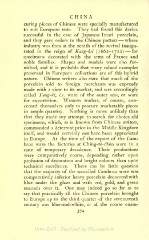Page 456 - Oriental Series Japan and China, Brinkly
P. 456
CHINA
curing pieces of Chinese ware specially manufactured
to suit European taste. They had found this device
successful in the case of Japanese Imari porcelain,
and they gave orders to the Chinese potters whose
industry was then at the zenith of the revival inaugu-
rated in the reign of Kang-hsi (16621722) for
specimens decorated with the arms of France and
noble families. Shapes and models were also fur-
nished, and it is probable that many valued examples
preserved in European collections are of this hybrid
nature. Chinese writers also state that much of the
porcelain sold to foreign merchants was expressly
made with a view to its market, and was accordingly
called Tang-ki, i.e. ware of the outer seas, or ware
for exportation. Western traders, of course, con-
cerned themselves only to procure marketable pieces
in ample quantity. Nothing is more unlikely than
that they made any attempt to search for choice old
specimens, which, as is known from Chinese writers,
commanded a deterrent price in the Middle Kingdom
itself, and would certainly not have been appreciated
in Europe. At the time of the export of the Cam-
bron ware the factories at Ching-te-chen were in a
state of temporary decadence. Their productions
were comparatively coarse, depending rather upon
profusion of decoration and bright colours than upon
technical excellence. There can be little question
that the majority of the so-called Cambron ware was
comparatively inferior heavy porcelain decorated with
blue under the glaze and with red, gold, and green
enamels over it. One may indeed go so far as to
say that practically all the Chinese porcelain brought
to Europe up to the third quarter of the seventeenth
century was blue-and-white, or of the coarse enam-
374

